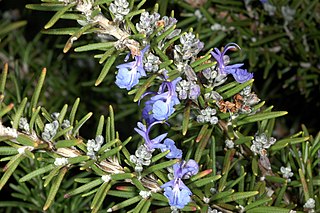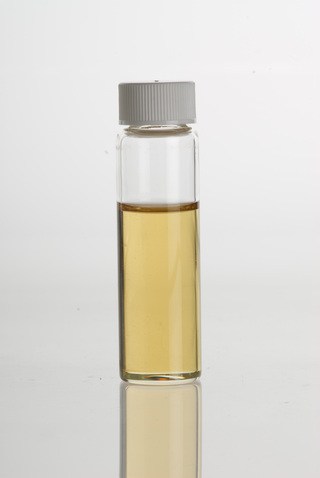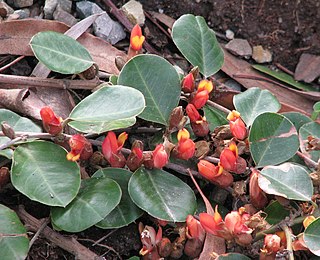
Salvia rosmarinus, commonly known as rosemary, is a shrub with fragrant, evergreen, needle-like leaves and white, pink, purple, or blue flowers. It is native to the Mediterranean region, as well as Portugal and Spain. Until 2017, it was known by the scientific name Rosmarinus officinalis, now a synonym.

Rosmarinus is a small taxonomic clade of woody, perennial herbs with fragrant evergreen needle-like leaves in the family Lamiaceae, native to the Mediterranean Basin.

Salvia officinalis, the common sage or sage, is a perennial, evergreen subshrub, with woody stems, grayish leaves, and blue to purplish flowers. It is a member of the mint family Lamiaceae and native to the Mediterranean region, though it has been naturalized in many places throughout the world. It has a long history of medicinal and culinary use, and in modern times it has been used as an ornamental garden plant. The common name "sage" is also used for closely related species and cultivars.

Salvia hispanica, one of several related species commonly known as chia, is a species of flowering plant in the mint family, Lamiaceae, native to central and southern Mexico and Guatemala. It is considered a pseudocereal, cultivated for its edible, hydrophilic chia seed, grown and commonly used as food in several countries of western South America, western Mexico, and the southwestern United States.

Stachys is a genus of plants, one of the largest in the mint family Lamiaceae. Estimates of the number of species vary from about 300, to about 450. Stachys is in the subfamily Lamioideae and its type species is Stachys sylvatica. The precise extent of the genus and its relationship to other genera in the subfamily are poorly known.

The genus Anchusa belongs to the borage family (Boraginaceae). It includes about 35 species found growing in Europe, North Africa, South Africa and Western Asia. They are introduced in the United States.

Lavandula angustifolia, formerly L. officinalis, is a flowering plant in the family Lamiaceae, native to the Mediterranean. Its common names include lavender, true lavender and English lavender ; also garden lavender, common lavender and narrow-leaved lavender.

Sage oils are essential oils that come in several varieties:

Salvia pratensis, the meadow clary or meadow sage, is a species of flowering plant in the family Lamiaceae, native to Europe, western Asia and northern Africa. The Latin specific epithet pratensis means "of meadows", referring to its preferred habitat. It also grows in scrub edges and woodland borders.

Anchusa officinalis, also knowns as common bugloss or common alkanet, is a species of flowering plant in the borage family. It is native to Europe and small parts of western Asia, but has been escaped from cultivation to grow in additional locations in Europe and the Americas. The flowers are noted for their popularity with bumblebees due to a large nectar flow. The plants have been used in traditional medicines, but were falling out of favor by the early 1800s. They are still planted in gardens for their popularity with bees and their blue flowers.

Salvia fruticosa, or Greek sage, is a perennial herb or sub-shrub native to the eastern Mediterranean, including Southern Italy, the Canary Islands and North Africa. It is especially abundant in Palestine, Israel and Lebanon.

Salvia candelabrum is a species of flowering plant in the family Lamiaceae, native to southern Spain. It is a woody-based perennial growing to 100 cm (39 in), with woolly grey-green leaves that resemble those of the common sage, S. officinalis, and emit a similar scent when crushed. In summer it bears violet-blue flowers on branching stems held high above the foliage.

Paeonia officinalis, the common peony, or garden peony, is a species of flowering plant in the family Paeoniaceae, native to mainly mountainous areas of Southern Europe and introduced in Central and Western Europe and North America.

Salvia is the largest genus of plants in the sage family Lamiaceae, with nearly 1,000 species of shrubs, herbaceous perennials, and annuals. Within the Lamiaceae, Salvia is part of the tribe Mentheae within the subfamily Nepetoideae. One of several genera, commonly referred to as sage, it includes two widely used herbs, Salvia officinalis and Salvia rosmarinus.

Salvia officinalis subsp. lavandulifolia, synonym Salvia lavandulifolia, is a small woody herbaceous perennial native to Spain and southern France, growing in rocky soil in Maquis shrubland, often found growing with rosemary, Lavandula lanata, and Genista cinerea.

A prostrate shrub is a woody plant, most of the branches of which lie upon or just above the ground, rather than being held erect as are the branches of most trees and shrubs.
Trifurcula salvifoliae is a moth of the family Nepticulidae. It is found in Spain.
Colchicum zahnii is a species of flowering plant in the familyColchicaceae. It is native to southern Greece. It blooms in mid-autumn from rhizomatous corms. The flowers can be variable coloured, being a pale purple-pink to white and are often held wide open. The leaves are produced at flowering time and usually number 2 to 3. This species is similar to Colchicum boissieri in that the corms grow into large patches, rather than tight clumps like Colchicum speciosum or Colchicum autumnale.

Iris attica, the Greek iris, is a plant species in the genus Iris, it is also in the subgenus Iris. It is a rhizomatous perennial, from the mountains of the Balkans in Europe, within the countries of Greece, former Yugoslavia, Turkey and North Macedonia. It has sage green or grey-green leaves, that are sickle-shaped, a stout short stem and 2 variable flowers, in shades from yellow to purple. They have a white or blue beard. It is often called Iris pumila subsp attica, but is classified in most sources, as a separate species, although it is closely related to Iris pumila, as a possible parent plant. It is cultivated as an ornamental plant in temperate regions.

Hypericum delphicum is a perennial herb in the St. John's wort family Hypericaceae, section Adenosepalum and the subsection Adenosepalum. It has a diploid number of 16.

















